DOWNTOWN QUEEN CREEK
ART AND PLACEMAKING
PLAN



ART AND PLACEMAKING


Town Leadership:
Julia Wheatley Mayor
Jeff Brown Vice Mayor
Robin Benning Council Member
Leah Martineau Council Member
Bryan McClure Council Member
Dawn Oliphant Council Member
Travis Padilla Council Member
Town Staff:
Doreen Cott Economic Development Director
Jennifer Lindley Downtown Development Manager
Erik Swanson Planning Administrator
Mallory Ress Planner II
Marnie Schubert Community Services Director
Brian McKean Chair
Derek Neighbors Vice Chair
Patrick Camunez Committee Member
Valerie Done Committee Member
Anita Lopez Committee Member
Lisa Dalton Committee Member
Whitney Tolle Committee Member
Consultant Team:

Josh Lapp Principal
Amanda Golden Managing Principal
Jasmine Metcalf Urban Planner
Alaina Foster Historic Preservationist

Amber Gough
Marketing and Communications Coordinator

This chapter contains an overview of the process by which this plan was developed alongside the overarching mission and guiding principles of the program. The chapter is concludes with the Community Character Framework which gives a window into the soul of Queen Creek.
The Downtown Queen Creek Art and Placemaking Plan aims to give the Town of Queen Creek the tools to transform the built environment of the Downtown area using public art and placemaking.
Our vision is for public art and placemaking to transform Downtown Queen Creek into an interactive, unique, and vibrant community center.
Through the planning process a series of strategies have emerged to help achieve the vision of a vibrant, creative Downtown Queen Creek:
• Tell the story - past, present, & future of Queen Creek.
• Help to build a walkable, bikeable, accessible downtown.
• Integrate art into new developments.
• Contribute to our agritainment identity.
• Connect to and display our natural environment.
• Create temporary and permanent opportunities.

Queen Creek, located in the southeastern region of Arizona, has a rich and vibrant history that stretches back to its earliest inhabitants, the Hohokam people. Archaeologists have dated the earliest Hohokam sites to the first century AD. Their civilization reached its peak between the 12th and 15th centuries. The Hohokam were known for their agricultural expertise, cultivating crops such as beans, corn, cotton, squash, and gourds in the arid desert. Unfortunately, in the 15th century the Hohokam culture mysteriously disappeared, which is how they received their name which means the “vanished ones.” Following the decline of the Hohokam, the land was inhabited by various Native American tribes, including the O’odham (Pima), Apache, and Yuma peoples.
In the early 1870’s the creek running through the area was originally called Picket Post Creek. The name taken from Picket Post Mountain as the creek ran by the base of the mountain five miles east of Superior. At the establishment of the Silver Queen mine near the creek (in what is now Superior), Picket Post Creek took on the name of the mine and became known as Queen Creek. That creek flows all the way through the community and is where the Town sourced its name.


During this Old West era the Andrade Ranch/Desert Well Stage Stop, operated between 1877 and 1916, and served as a crucial rest stop for the California and Arizona Stage Company, offering water, and shade for weary travelers. The stage stop featured a well that reached a depth of 114 feet and held about 14 feet of water. After Andrade sold the well and ranch in 1906 various individuals would own the property until the 1930’s when Ernie Hawes became its owner. Remnants of the original stone and mortar water tank for the well are preserved at the northeast corner of Sossaman Road and Chandler Heights Road.
Work began on the Phoenix and Eastern Railroad in 902. The line reaching Winkelman by 1904, provided a vital transportation link for the community. By 1910 the line was being run by the Arizona Eastern Railroad. The Doodlebug was a gas-electric motor car that provided local passenger commuter rail service in the Queen Creek community from 1914 to 1940 to neighboring towns and to Phoenix. The railroad played a vital role in the support and growth of Queen Creek.
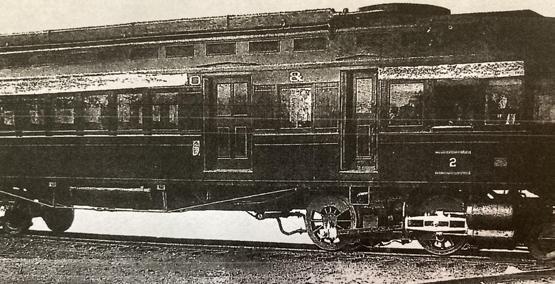

In the mid-19th century, the opportunity for settlement in the West arose with the passage of the Homestead Act of 1862. In Arizona, farming proved incredibly challenging, and many homesteaders were forced to give up or sell their land. In Queen Creek, by the 1920’s Charles Rittenhouse had come into the area and introduced large-scale irrigation with his diesel engines and irrigation pumps. Rittenhouse played a vital role in the establishment of farming in the area. He built multiple wells in the area enabling the cultivation of a variety of produce and cotton. Rittenhouse defaulted on his bank loan in 1928 and as a result Leo Ellsworth purchased Rittenhouse’s properties.
Leo and his brothers formed The Ellsworth Brothers Farms, a sprawling operation encompassing approximately 100,000 acres. Through sharecropping and mutual partnerships, they cultivated cotton and produce, raised cattle, sheep, and maintained a dairy herd. The installation of a railroad siding during Rittenhouse’s time facilitated the shipment of these agricultural products, further promoting the Town’s commercial development. Leo Ellsworth also played a pivotal role in what became downtown Queen Creek. The Ellsworth Brothers office, store and gas pumps were at the southwest corner of Ellsworth Road and Ocotillo and became one of the focal points of the community.


Between the 1920’s and 1930’s some of the impactful settlers began to arrive leaving their names as a reminder to the Town’s origins. Family names such as the Germanns, J.O. Power, Jasper Sossaman, Hawes, Brandon, and Crismon. All of these families played significant roles in the community’s development.
In the 1920s and 1930’s, farm work was labor intensive. During that time the majority of farm workers in Queen Creek were Filipino and Mexican immigrants. The Mexican farm workers and their families would become an important part of the Queen Creek community. In the 1940s, because of the lure of higher paying defense plant jobs in California many farm workers left the area for those jobs. As a consequence, farm owners made arraignments with the Army to bring in German Prisoners of War to work the fields. These German P.O.W.’s were mostly submariners housed at the Papago Park P.O.W. camp. A satellite P.O.W camp was established for these submariners at the northwest corner of Rittenhouse Road and Ellsworth Road. These German P.O.W.’s had their own doctor who occasionally treated local residents.

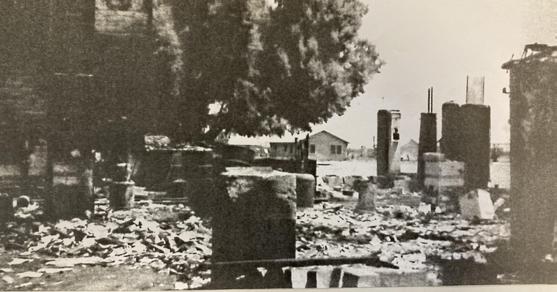
A couple of significant events in the Town included construction of a new schoolhouse on Ellsworth and Queen Creek roads in 1925 which was named after Charles Rittenhouse. On July 1, 1943, a fire burn down the Ellsworth businesses’, and in essence downtown Queen Creek. The gas station was rebuilt and in addition a larger store was built and leased to the Wright’s Market company. The gas station and adjoining Ellsworth businesses became the core of old town Queen Creek.
The area of Queen Creek is especially adapted for potato harvesting so potato sheds along with cotton gins were common structures to see in the landscape. Potato farming was a large portion of the local agriculture. The local climate made it possible to perform the potato harvesting earlier than anywhere else and thus they could get them to market first. The Queen Creek siding and Rittenhouse siding played a crucial role in the community’s development as it was a means for the Town to transport agricultural goods to market.


Queen Creek’s growth was further marked by the establishment of various religious and community institutions. The Arizona Boys Ranch was established in 1948. It was necessitated by the stance that homeless boys should have the opportunity for home, school, and community regardless of their background. The founding of the ranch, which is now known as Canyon State Academy, was supported by many in the community. The ranch aimed to provide material support for the boys and staff through farming and livestock programs.
On September 5, 1989, Queen Creek officially incorporated as a Town after a struggle to regain a strip of annexed land. This fight led to new legislation in Arizona, outlawing strip annexation. In 1990, just after the Town incorporated, Queen Creek’s population was just over 2,500. The next 10 years, Queen Creek experienced a relatively rapid growth rate, with the Town’s population escalating significantly by 2010. The Great Recession tempered growth for several years, but by 2015, Queen Creek was one of the fastest growing communities in Arizona. The Town’s population continued to increase at a steady, manageable pace, with an estimated population of 76,500 in 2023. The Town was also the seventh fastest growing community in the entire country in 2023. Queen Creek is a thriving suburban community and remains home to some of the founding families. It has witnessed significant changes over the years, reflecting the rich history and growth of the Town.

2:
Our vision is for public art and placemaking to transform Downtown Queen Creek into an interactive, unique, and vibrant community center.
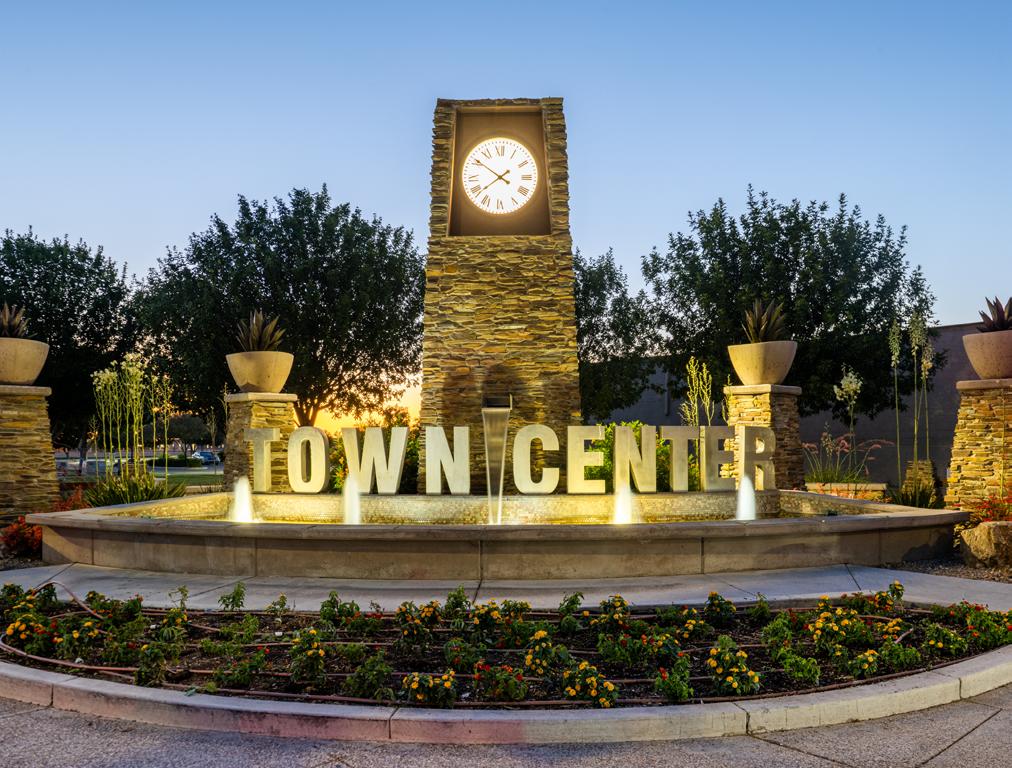
Tell the story - past, present, & future of Queen Creek.
As a community with a rich history but also a dynamic future, art and placemaking elements can build upon and deepen the story of Queen Creek for residents and visitors.
Help to build a walkable, bikeable, accessible downtown.
Art and placemaking features encourage residents and visitors to get out and explore the community on two feet or two wheels. These features create destinations and interest in the built environment.
Integrate public art into new developments.
Much of Downtown Queen Creek is ripe for infill development. Art and placemaking elements could be integrated into these developments to help create a unique draw as well as differentiate Downtown Queen Creek from other nearby communities.
Contribute to our agritainment identity.
Queen Creek is well known for its agricultural legacy that continues to the present day. Art and placemaking could continue to connect and celebrate that legacy, cementing the identity of the community in the eyes of residents and visitors. This is particularly important in Downtown Queen Creek as many of the agritainment venues are outside of the Downtown Core.
Connect to and display our natural environment.
The stunning desert environment of Queen Creek is a key feature of the landscape. By incorporating elements of the natural environment into art and placemaking elements, the connection to that environment can be deepened within the community.
Create temporary and permanent opportunities.
By focusing on both permanent and temporary art and placemaking features, Queen Creek can create a solid foundation with ephemeral interest drawing residents and visitors to the Downtown area again and again.
CHAPTER 3:
There are many ways to approach placemaking in Downtown Queen Creek. This chapter specifies ideal methods and opportunities for implementing unique Queen Creek focused projects. Showcased are specific types of public art and placemaking features that would be ideal for Queen Creek.
Whether contemporary, whimsical, traditional or something more, sculptures are often the focal points of civic art. Sculptures may commemorate and celebrate our history, express civic pride, or be established as culturallydefining showpieces for the Town.
Sculptures can take on many shapes and sizes and often fit well when created in or alongside gateways, parks, gathering spaces, roundabouts, and community centers. Because communities can celebrate and enhance their civic identity, they are especially appropriate in parks and downtown settings.


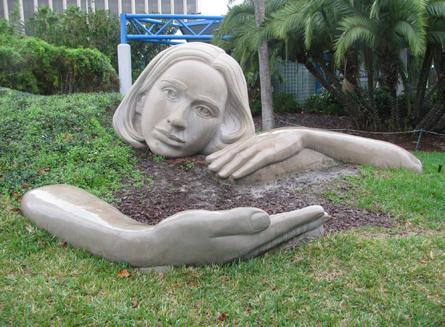
There is a unique opportunity to implement designs in place of otherwise ordinary pieces of infrastructure. Integrating unique ‘Queen Creek’ designs into infrastructure may be an affordable and efficient way to create a major visual impact.
Some possible options for functional art installations include bike racks, benches, play equipment, medians, subdivision walls, trash cans, transit stops, storm drains, manholes, monument signage, sidewalk treatments and more.
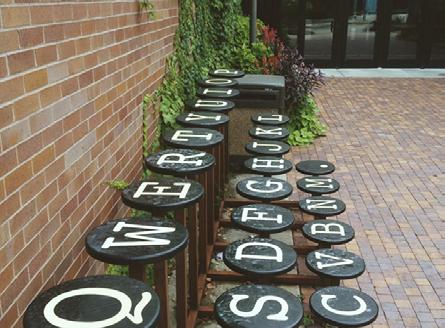

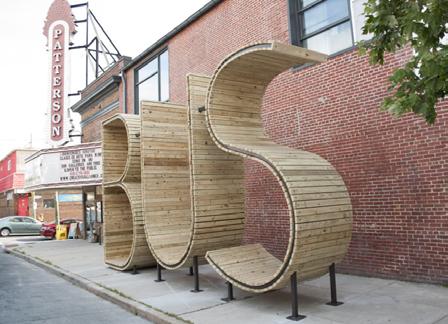
While curating permanent works of art as part of the collection is important, ephemeral works such as murals allow for the exposure of many artists over a short period of time rather than a few artists over a long period of time.

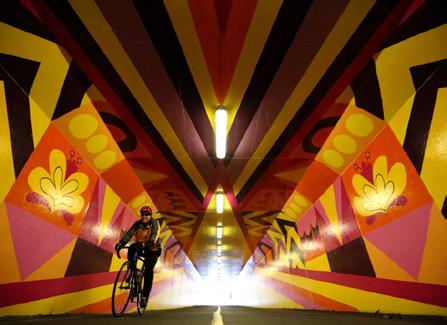

Contemporary artists use lighting in creative and interesting ways in order to manipulate the built environment with limited physical impacts. Light installations may be used on existing buildings, in parks on substantial landscape features, or as part of a larger installation of sculpture. They may be especially useful and impactful when used in infrastructure projects.
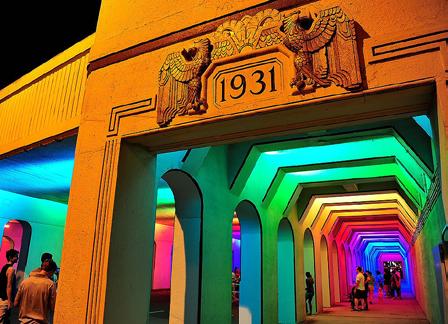


Mosaics come in many shapes and sizes and include glass or ceramics. The relative flexibility of the application of mosaics responds well to many art contexts.
Whether they be functional like the bench mentioned above, internal such as inlaid in flooring, or as a stand-alone exterior element - mosaics can help to enrich the built environment.

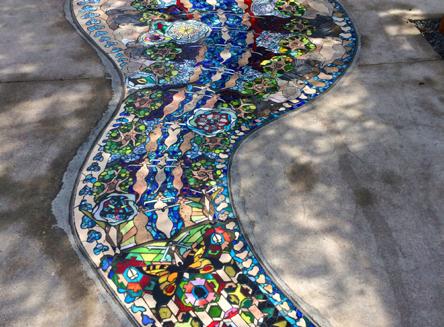

Multimedia installations may combine many art types in ways that expand the imagination. Video, lighting, sculpture, murals, and more can be combined to make multimedia installations some of the most interesting around. Multimedia installations are especially useful for temporary or popup installations.
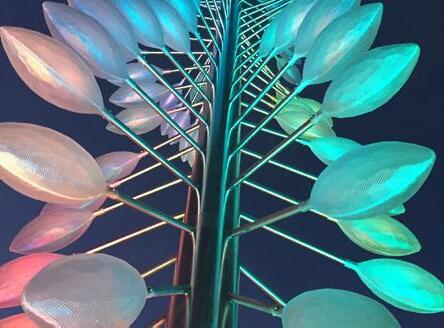
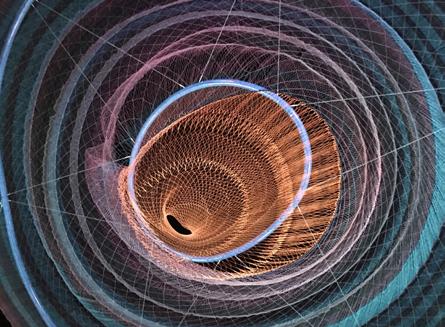

Textiles span the gauntlet from wall hangings to giant masterpieces that visually impact public spaces. This form of art can be used to add interest to new spaces or existing spaces within our public buildings.



Dance, theater, spoken word, or another type of public performance is an ideal opportunity to be staged in public space or alongside public art in Queen Creek. These displays have a particular relevance when staged at the unveiling of public artworks.
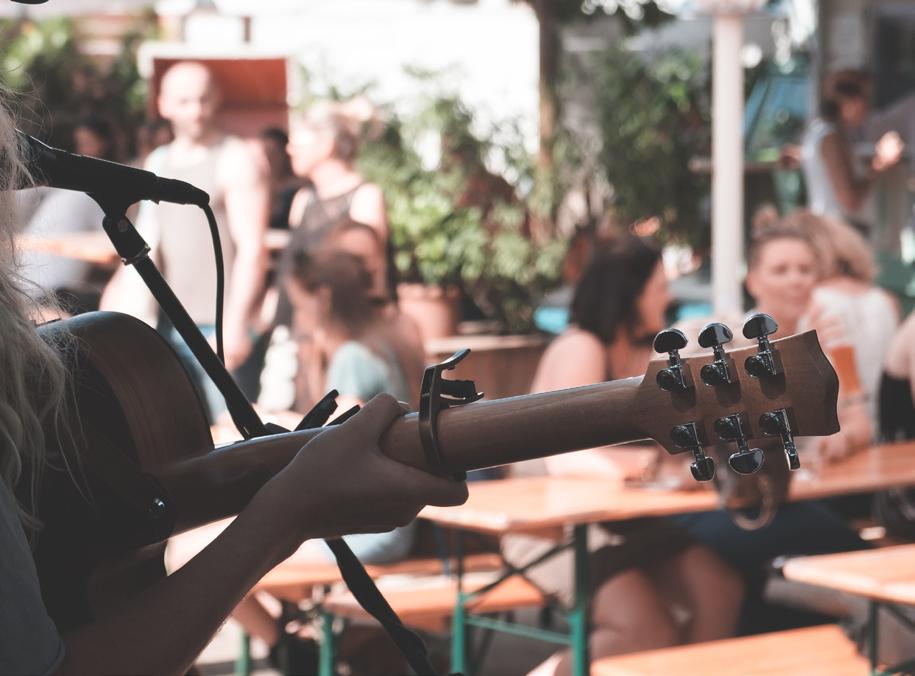
Art can be long-lasting, or it can be something experienced for a short period of time. Though temporary art is not intended to live for a generation, it can have a lasting impact on a community by creating a sense of surprise and joy in unexpected places. Some ideal locations for temporary installations include construction sites, sidewalks, alleyways, parks, and temporarily empty spaces and storefronts.

Temporary art can be done inexpensively and easily, provide opportunity for additional artist engagement, and it can be a small investment for a huge impact. In whatever form, its short lifespan gives energy to the space and drives excitement among the community. Temporary art invites collaboration, be it with local schools or community groups, and creates opportunity for the artwork to evolve with the community over time.
Participatory art is more focused on the creation of an art piece than any of the typologies listed above. Specifically, a piece is made by the community to enhance and celebrate its process and participants. Collaborative art pieces use people to enrich the experience and heighten the feeling of pride and ownership.
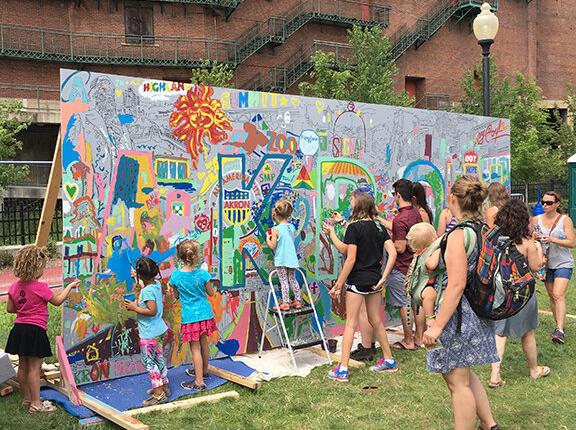

Site-specific art is created to enhance and celebrate its surroundings in which an artist considers the site first before anything else. Site-specific art uses the surroundings to enrich the experience of the place itself. It can help to tell the story of the location, neighbors or residents, or simply exist to elevate the site.

Street Bulb is defined as curb extensions that align a bus stop or rideshare pull off with the parking lane, allowing vehicles to stop and board passengers without leaving the travel lane.
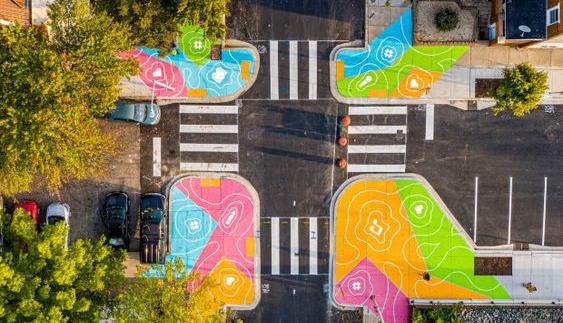
Curb Extension is defined as a way to visually and physically narrow the roadway, creating safer and shorter crossings for pedestrians while increasing the available space for street furniture, benches, plantings, and street trees. (National Association of City Transportation Officials)
Creative crosswalks use colors, textures, and patterns to enliven streets as engaging and safe places for people. There are two types of crosswalk markings. The first type includes painting on existing pavement using a stencil and traffic paint. The second type requires more extensive implementation which consists of heat stamping the pattern and applying paint in the depressed area.
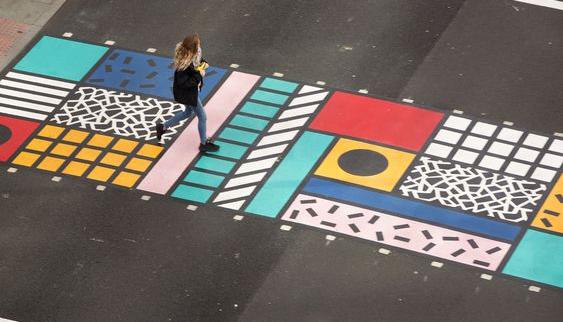
For trails and low traffic walks and drives, the painting technique is appropriate. For high traffic areas, the heat stamping technique is most appropriate because the paint is at the same level as the adjacent pavement and therefore won’t peel off during plowing or street cleaning activities. Generally, the heat stamping technique is more expensive and should only be used when necessary.

Parklet is a sidewalk extension that provides more space and amenities for people using the street. Usually, parklets are installed on parking lanes and use one or several parking spaces. Parklets typically extend out from the sidewalk at the level of the sidewalk to the width of the adjacent parking space.
Within Queen Creek, shade structures can be used for more than just protection from the sun. These features can become expressive visual elements or works of public art that have both form and deliberate function.
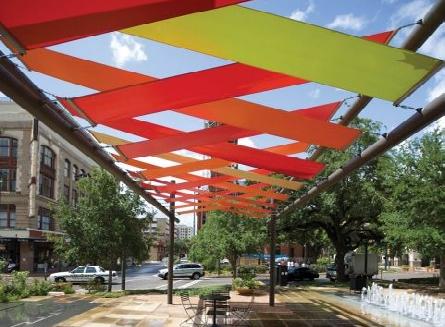
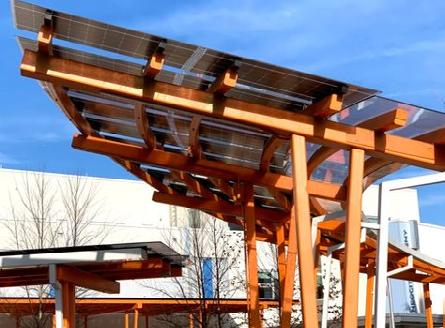

Rather than using standard fences in new development in the Downtown area, unique patterns and color schemes could be used that are incorporated into the design of the fence infill panels.


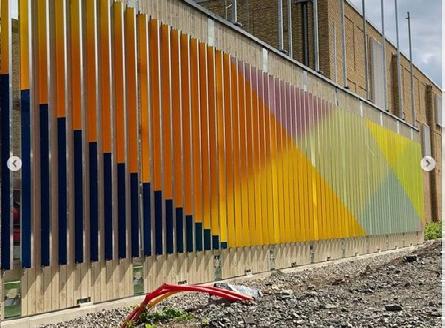
Adding decorative benches will not only add visual elements but also encourage visitors to sit and stay awhile.



Whether plantings, or other site furnishings, landscape features can be used as or in conjunction with public art to enhance the built environment by telling the story of Queen Creek.



Why Public Private Partnerships for Art & Placemaking?
Public Private Partnerships (P3s) are the foundation of redevelopment in Downtown Queen Creek area. As the Town looks to implement Public Art and other placemaking projects P3s remain key opportunities for success for executing projects.
Key Partners
There are a series of partners that will be key in moving public art and placemaking focused Public Private Partnerships forward. These partners are detailed on the following pages.
Downtown Queen Creek is quickly growing into its own with large amounts of new housing and commercial buildings being constructed. Developers will be key partners to ensuring that public art is placed throughout the downtown area.
Key Opportunities for Public Private Partnerships:
• The inclusion of public art in new developments voluntarily or as part of negotiated development agreements


As the business environment in Downtown Queen Creek expands we will be looking to business owners as key partners when executing projects. They can also help to provide direction as public art and placemaking projects are implemented in the future.
Key Opportunities for Public Private Partnerships:
• Hosting events, particularly arts focused events, in conjunction with the Town or independently
• Displaying artwork, including public art
One of the key draws of Queen Creek for visitors outside the community, are the unique agritainment (agricultural plus entertainment) venues within the community. These businesses showcase the legacy of the community and by creating a strong sense of place in the downtown area we can create an even larger ecosystem that will boost both the venues and the downtown area. These key venues are:


Arizona’s only family-owned and operated working olive mill and farm, where olives are grown and pressed for the production of high quality extra virgin olive oil. Experience their Olive Oil 101 class (offered hourly) and enjoy complimentary tastings of oils, olives and vinegars. Visitors are invited to dine at the Mill’s Tuscan-inspired eatery featuring fresh gourmet sandwiches, paninis as well as soups, salads, gelato and fresh roasted espresso from Infusion Coffee & Tea. Relax in their olive grove with libations at The Pit, featuring specialties from the grill.

Visitors can explore the one-of-a-kind Schnepf Farms – celebrating 75 years of operation. This fourth generation family farm and the largest organic peach grower in Arizona is a must-do in the Phoenix area. If planning a day trip, make sure to visit the website and see what’s happening that week on the farm. Guests may be able to experience everything from peach picking to watching a historical re-enactment, enjoying a classic car show, or an antique craft fair, fireworks, one of the unique seasonal farm festivals, ice skating, or just picking veggies in the u-pick garden.


 Hayden Flour Mills at Sossaman Farms
Queen Creek Botanical Gardens
Hayden Flour Mills at Sossaman Farms
Queen Creek Botanical Gardens
There are a large number of artists in Queen Creek and the surrounding areas and the Town could work to create opportunities for these artists when possible. Due to the nature of public art, many large commissions may utilize national public artists, but the Town could ensure to create smaller scale opportunities geared specifically for local artists. The Town could also work to promote public artists in campaigns and other promotional material.


In order to facilitate public art in Downtown Queen Creek a new ordinance or internal policy could be implemented that: defines what public art is and establishes the Downtown Art & Placemaking Advisory Sub Committee as the body that reviews Public Art in Queen Creek.
The key elements needed to move public art forward in Downtown Queen Creek are:
• Formalizing the definition of Public Art
• Formalize the role of the Downtown Art & Placemaking Advisory Subcommittee Committee
The Downtown Art & Placemaking Advisory Subcommittee will have the following responsibilities:
A Support staff in establishing criteria and eligibility standards for applicants of projects;
B Support staff in establishing criteria for awarding projects;
B Support staff in identifying funding sources for art projects through donations, sponsorships and/or private funding.
C Support staff in evaluating proposed donations of public art;
D Support staff in evaluating removal of artwork from public display; and
E Act principally in an advisory capacity to staff in any matter pertaining to public art.
The following is a sample definition of public art that can be the basis for the formal definition for Queen Creek.
Public Art or Artwork or work of art means an original physical work created or produced by an Artist that is accessible to the public. Artwork may be free-standing or integrated with the work of other design professionals into a building or site. Artwork may be new or may be an existing work of art. Artwork may include, but is not limited to:
• Sculpture: Free-standing, wall supported or suspended; kinetic, electronic; in any material or combination of materials.
• Murals or portable paintings: in any material or variety of materials.
• Fiber works, neon, glass, mosaics, photographs, prints, calligraphy, earthworks, any combination of forms of media, including light, sound, literary elements, film, holographic images, and video systems; hybrids of any media and new genres.
• Furnishings or fixtures, including, but not limited to gates, fences, railings, lighting, street lights, signage, seating, if created by artists as unique elements or limited editions.
• Artistic or aesthetic elements of the overall architecture or landscape design if created by a professional artist or a design team that includes a professional visual artist. Such design elements may include pools, paths, benches, planters, and fixtures and vegetative materials where designed by a professional visual artist and/or are an integral part of the artwork by the artist.
• Temporary artwork or installation that serves the purpose of providing community and educational outreach.

The following are not considered artwork for the purposes of Public Art funding:
Art objects which are mass produced or are of standard manufacture, such as playground equipment, fountains, statutory elements, signage, maps, corporate logos or other functional elements, unless incorporated into an artwork by an artist commissioned for that purpose.
1. Reproductions, by mechanical or other means, of original artwork, except in the case of limited editions controlled by the artist, cast sculpture, film, video, photography, printmaking, or other media arts.
2. Decorative, ornamental, architectural, or functional elements which are designed by the building architect as opposed to elements created by an artist commissioned for that purpose.
3. Artwork in Town facilities that are within employee offices or spaces.
4. Services or utilities necessary to operate and maintain an artwork over time.

The following outlines policy templates that could serve as the basis of public art in Queen Creek. Policy templates that have been provided to the Town as part of this planning process can become the basis of these future policies.
This policy establishes the mission, vision, and guiding principles for the program as well as overall definitions for the policy.
This policy establishes the practices for acquiring artworks. This detailed policy will ensure a transparent process for acquiring artwork and favors open ended selection processes in order to promote artistic excellence and further the goals and strategies of the program.
This policy establishes the management practices of artworks acquired through the solicitation and donation processes. These pieces are considered part of the Town’s Permanent Collection and must be cared for in accordance with the Policy and Procedure for Maintenance Policy and the Collection Management Policy. The Collection Management Policy is intended to maintain the value of the Town’s Permanent Collection and guard against inappropriate disposal of any of its pieces.
This policy establishes the donation process for artworks not commissioned by Queen Creek. Each proposed donation must come with a plan to fund and deliver ongoing maintenance, or the resolution accepting the public art must identify how maintenance of the donated public art will be funded. Donation requirements, responsibilities of the donating party, and the process for donating a piece of public art are outlined in this policy.
This policy establishes the procedure for maintenance of the future art collection. Direction for surveying the collection, working with future artists to establish a maintenance plan for any commissioned work, and inspection guidelines are included.
The Administrative Guide outlines the roles and responsibilities of citizens, Town staff and elected officials in the development, funding and implementation of Queen Creek Public Art Program. The Plan provides guidelines and requirements for the development of an annual Public Art Work Plan, the funding and acquisition of public art, the selection of artists and artwork, the implementation and conservation of the Queen Creek Public Art Collection.

The Mural Guidelines offer guidelines for both publicly-owned murals on public and private property and consider the process for approval. The guidelines consider the ownership of the building in which the mural will be sited.
This policy gives overall guidance on how to both limit negative environmental impacts as a result of the implementation of public art. The policy also gives direction to help ensure public art projects in Queen Creek are not negatively impacted by the desert climate.
This policy details how Public Art Program funds may be used throughout the development and implementation of public art projects.

Executing public art and placemaking projects can be time consuming for staff. This plan envisions that projects will be executed by the Economic Development Department. In the short term, the Downtown Development Manager would take the lead role in acting as the Public Art Coordinator with assistance from other staff. As projects and programs are developed more capacity will likely be needed. That capacity could be filled by either a Town staff member or an outside consultant who can undertake the responsibilities of a Public Art Coordinator and hired on a project by project or as needed basis.
The Downtown Development Manager and/or outside consultant acting as the Public Art Coordinator has the following responsibilities:
Ҍ Develop and implement an annual Public Art Work Plan in coordination with the Downtown Art & Placemaking Subcommittee and appropriate Town departments and representatives.
Ҍ Oversee the administration of the commissioning of new works of public art including, but not limited to:
Ҍ Project planning - developing scopes of work and project budgets, coordinating with the project manager and project architect, and identifying community partners when necessary.
Ҍ Management of the artist selection process - developing and distributing RFQs and RFPs, staffing the artist selection committees, and conducting artist workshops.
Ҍ Project implementation - developing contracts, getting necessary approval, coordinating with the project manager, reviewing preliminary and final designs, and monitoring artist progress and compliance with the project contact.
Ҍ Documentation- keeping records of contracts, photographs,
construction drawings, maintenance manuals, and meetings.
Ҍ Community education - assist in garnering publicity for projects, facilitating public meetings, and developing educational materials.
Ҍ Ensure adequate insurance and liability protection is secured by artists, contractors, and the Town prior to installation.
Ҍ Coordinate any necessary management agreements through artists, contractors, community groups, private property owners, and the Town as needed.
Ҍ Monitor private development projects to assist private developers in including public art in their developments and guide them, when requested, through the process of placing public art within their projects.
Ҍ Identify collaborations and sources of funds.
Ҍ Ensure all necessary repairs are conducted to existing public art
Ҍ Serve as a liaison between the Town, artists, and/or business organizations relative to the Public Arts Program.
Ҍ Report to the Downtown Development Manager if consultant.
Ҍ Support the Downtown Art & Placemaking Subcommittee.

A quick, easy, and efficient way to bring public art into the built environment is by creating a functional art program. This could include common elements throughout the Downtown area or site specific works at each location. These could be small-scale sculptures or other easy to implement elements like utility box wraps.
Key Locations Include:
• Existing Downtown Streetscapes
• New Downtown Streets
Founders Park


A small scale mural program could identify locations, both publicly owned and private, for mural interventions directly on walls, utility boxes, or even stand alone installations. This could also include murals that are vinyl wraps which are less physically impactful and create opportunities for other artists such as photographers, digital illustrators and more.
Key Features:
• Rotating
• Multiple Artists
• Could include murals as part of the existing facade improvement grant
New permanent parklets are included as part of the construction of the new key Downtown roadways, Munoz and Aldecoa, and these are ideal opportunities for the addition of public art or highly designed placemaking elements.
This could include
• Shade Structures (artist-designed)
• Small Scale Sculptures
• Rotating Mural Opportunities
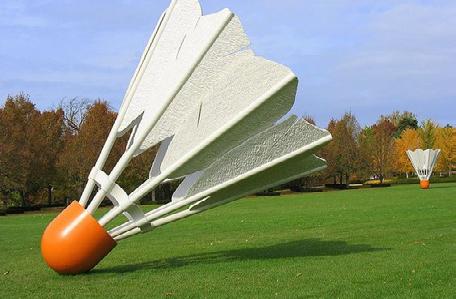

The recent Town Center Plan calls for the concept of a Village Green. Implementing the Village Green would create key opportunities for both small scale and signature public art.
Key Opportunities
• Small Sculpture
• Fountain
• Large-scale Signature Sculpture
• Mosaic Walls
Downtown Queen Creek is a key connection point from the Queen Creek Trail. By adding public art both on the trail and at key trail entry points the connection between the trail and the Downtown Area can be enhanced.
Public Art at this location could connect to nature and the history of the community and could also be placed at key entry and exit points to the trail.
• Connecting to Old Ellsworth


Queen Creek has done great work in the past developing gateway monuments. As the community has continued to grow, additional opportunities for gateway monuments have arisen. These include:
• Industrial area
• Downtown area
• Agricultural area
Currently there is temporary signage along Ellsworth & Rittenhouse that is rotated out for various events throughout the year. More permanent signage and other improvements could be made to ensure that the signage is high quality but maintains a hometown feel.
Opportunities include:
• Light installation
• Permanent Sign Installations that allows for rotating signs or dates
• Downtown Entry Sign


Queen Creek’s identity exists mostly in the minds of visitors and residents, not in the physical environment. By creating a large-scale iconic symbol for the community the identity of the community can be brought to life.
Like every queen, Queen Creek needs a crown! This could be a giant playable piece of public art that lives on its own or it could be constructed as the component of another park or playground. This would provide an iconic experience as well as a photo opportunity for residents and visitors alike.
• A Beacon that lights when an event is happening downtown.
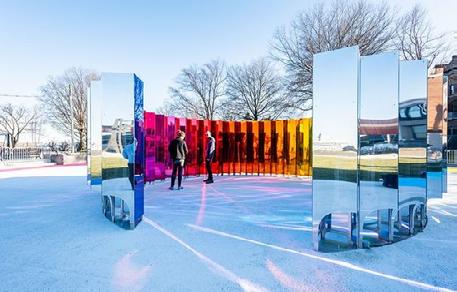

Installations and festivals that revolve around temporary public art or other experiential activities can help draw attention and visitors to Downtown Queen Creek. This could include large experiential public art, a mural festival or other art creation and more.
The Town has successfully invested in the installation of Christmas lights and other holiday decorations in the Downtown area. This could continue with an eye towards growth and expansion that could include public art or other artistic displays.
Opportunities include:
• Playable Installations
• Interactive Installations
• Winter Market



Banners that are designed by artists or promote arts and culture events are a lower cost way to transform less engaging architecture into something more compelling. The example shown is from Milwaukee Public Museum.


Artist designed crosswalks provide greater visibility to traffic and naturally encourage vigilance and caution when moving through them, increasing safety and pedestrian experience.

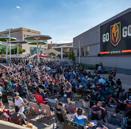
Site furnishings designed by artists or by designers collaborating up with artists make parks more engaging and interesting. Shown here is A Solar-Powered Bench That Spins Ever So Slowly by ENESS. As the name states those that sit on the benches are gently rotated.

One tactical art intervention that could be utilized on potential development sites are temporary art structures that would drive traffic and community interest to the site. The spaces could then be programmed in line with the future development to create excitement. An example would be a beer garden where a brewery is proposed.
Artwork along a trail can provide points of interest for trail users, act as a wayfinding strategy, and generally create a greater connection between the surrounding community and the trail itself. Shown here is Cacti by James Peterson.
A Village Green could provides opportunities for programming centered around art, culture, and community. If a village green is developed site interventions such as functional art, site furnishings, and iconic artwork should be considered to create an engaging community experience.


Parklet interventions, shade structures, and rotating sculpture installations can be used to create more interesting streetscapes. Parklets are also a great way to enhance the pedestrian experience and encourage people to linger longer near businesses located on streets where they are installed.
Founder’s Park is an iconic Queen Creek destination and it deserves an iconic piece of art. A large scale sculpture or other art piece would be a compelling addition to this well-loved community space.

